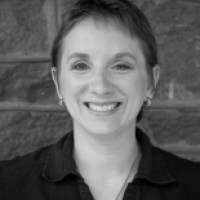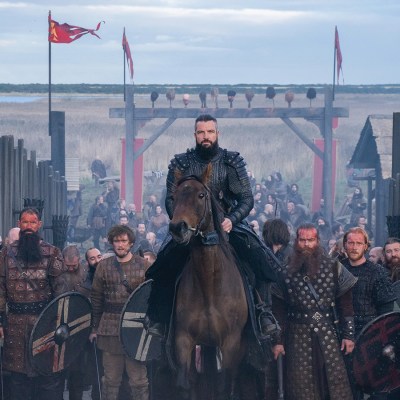Caroline Henderson on Bringing Her Vikings: Valhalla Heroine to Life
In an age dominated by male warriors, Vikings: Valhalla actress Caroline Henderson discusses the task of creating the renowned heroine Jarl Estrid Haakon in this interview.

This article is from the Den of Geek x Vikings: Valhalla Special Edition Magazine created in paid partnership with Netflix. You can read the full digital issue here!
Vikings: Valhalla returns viewers of the original series to the fictional town of Kattegatt—but a lot has changed in the past hundred years. Caroline Henderson plays Jarl Estrid Haakon, an equally fictional leader, who wisely rules over the now cosmopolitan port city.
While there was a Viking called Haakon Sigurdsson, also known as Haakon Jarl (‘jarl’ is an Old Norse word for a chief or earl), Henderson’s character bears no relation to him at all. Instead, the fictional Jarl Haakon may be used to create a connection with some of the characters from Vikings, possibly as a descendant of Ragnar Lothbrok.
Den of Geek sat down to chat with her about what makes her character tick—and what it’s like to be a part of reinventing the way viewers look at Viking history.
Den of Geek: Even though this is a series full of male characters, there are so many strong women. Was that part of the appeal?
Caroline Henderson: Definitely part of the appeal—and also because we live in Scandinavia, so we are familiar with the whole history part [rather than] the romantic fairy tale of the Vikings. We learned in school about the fierce women warriors—and the power that women had.
How does Jarl Haakon fit into that history?
In history books, you don’t follow women—just the men, right? You might occasionally know about women if they’re Queens and princesses because of the line of the Kings. My character’s name is Estrid which is a common name here in Scandinavia, and Haakon is her last name—probably from her father—which is also a very common male name in Denmark, Sweden, and Norway.
We know from DNA and such that the Vikings were travelers; they traveled to Northern Africa, Asia, all kinds of places. Obviously, they brought back slaves and knowledge—but also fell in love. Most likely, people of color have [always] existed in the [Viking] community. I think it’s amazing to bring that to her story, because that’s closer to the [historical] truth I think, than what we’ve seen [in Viking stories] so far.
The Vikings: Valhalla Kattegatt really fits into that vision of Vikings and travelers from all over the world so much better than many popular representations of Viking culture. What was it like to be on that set?
Nothing can prepare you for that level of [immersion]. It’s so exciting. I try to play it cool of course, like something I’ve seen before, but to see horses, villages, and life-sized Viking ships was jaw-dropping, and really intimidating at first. But then you get used to it so it’s just like, “OK, another day at the office.” But it was amazing.
Viewers may not realize that you’re a real-world knight of Denmark.
Yes, I am. I did a lot of things for the queen and the country, going to different countries, singing, representing [the country]. Not everybody will get something like that. I can tell you that meeting King Canute [played by Bradley Freegard] was so surreal for me because our queen right now is in line with King Canute. If somebody would’ve told me 15 years ago that I’d be doing this, I wouldn’t have believed it.
Is this your first historical role?
No, I did another piece last year, but that was completely different. But it’s so exciting because I love history. It’s just such a joy.
Right now, there’s an interesting exhibition in Copenhagen about Viking history. I went there, thinking, “Oh my God, I have to dig into this.” It’s such a vibrant and interesting time in history, I think even more than 200 years before [the conflict between Christianity and pagancy] changed all Europe; it changed the borders for countries. It certainly changed [things] for women. For some of the female characters, we can only imagine that women like these probably did exist—but we don’t know because [historians] didn’t write about them, did they?
Was anything challenging about the period costumes?
The only problem I have with my costume is if I have to go to the ladies’ room! I was so spoiled. Some of the others had one costume, but I, as a Jarl, had loads of dresses and pieces. I loved every second of it. [It was] a little bit difficult to get off and on the horse. But other than that, it was like a dream come true. I felt so regal.
What is your favorite thing about your character?
I think in a sense she’s sort of me a thousand years before. I am from a very high-profile Swedish, posh, predominantly white family. And my father was African American. I can follow my ancestors on my Swedish side because they were like priests, and they owned land many hundreds of years back. So it feels like I’m sort of her but in a modern version.
We spoke before about her fierceness. She’s so strong. She’s a warrior, and she is wise. Like many women leaders, she’s wise without being aggressive. I love that she has been able to hold peace so far within Kattegat. But she has a vulnerable side, too.
What I also love about the part that’s very modern to me, is that in Kattegat, she says all religions, all colors, all faiths—everybody’s welcome, because we have to learn how to live together, which we haven’t learned in thousands of years.

